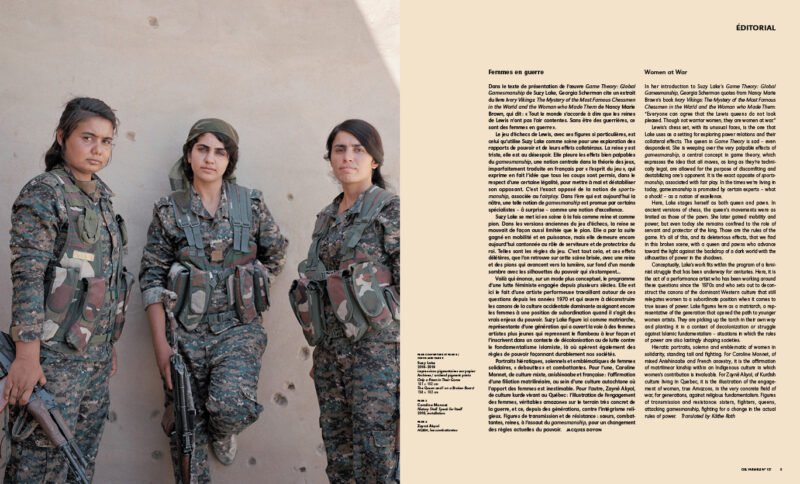[Fall 2024]
[Automne 2024]
Éditorial
par Jacques Doyon
In her introduction to Suzy Lake’s Game Theory: Global Gamesmanship, Georgia Scherman quotes from Nancy Marie Brown’s book Ivory Vikings: The Mystery of the Most Famous Chessmen in the World and the Woman who Made Them: “Everyone can agree that the Lewis queens do not look pleased. Though not warrior women, they are women at war.”
Lewis’s chess set, with its unusual faces, is the one that Lake uses as a setting for exploring power relations and their collateral effects. The queen in Game Theory is sad – even despondent. She is weeping over the very palpable effects of gamesmanship, a central concept in game theory, which expresses the idea that all moves, as long as they’re technically legal, are allowed for the purpose of discomfiting and destabilizing one’s opponent. It is the exact opposite of sportsmanship, associated with fair play. In the times we’re living in today, gamesmanship is promoted by certain experts – what a shock! – as a notion of excellence.
Here, Lake stages herself as both queen and pawn. In ancient versions of chess, the queen’s movements were as limited as those of the pawn. She later gained mobility and power, but even today she remains confined to the role of servant and protector of the king. Those are the rules of the game. It’s all of this, and its deleterious effects, that we find in this broken scene, with a queen and pawns who advance toward the light against the backdrop of a dark world with the silhouettes of power in the shadows.
Conceptually, Lake’s work fits within the program of a feminist struggle that has been underway for centuries. Here, it is the act of a performance artist who has been working around these questions since the 1970s and who sets out to deconstruct the canons of the dominant Western culture that still relegates women to a subordinate position when it comes to true issues of power. Lake figures here as a matriarch, a representative of the generation that opened the path to younger women artists. They are picking up the torch in their own way and planting it in a context of decolonization or struggle against Islamic fundamentalism – situations in which the rules of power are also lastingly shaping societies.
Hieratic portraits, solemn and emblematic of women in solidarity, standing tall and fighting. For Caroline Monnet, of mixed Anishinaabe and French ancestry, it is the affirmation of matrilinear kinship within an Indigenous culture in which women’s contribution is invaluable. For Zaynê Akyol, of Kurdish culture living in Quebec, it is the illustration of the engagement of women, true Amazons, in the very concrete field of war, for generations, against religious fundamentalism. Figures of transmission and resistance: sisters, fighters, queens, attacking gamesmanship, fighting for a change in the actual rules of power. Translated by Käthe Roth
[ Complete issue, in print and digital version, available here: Ciel variable 127 – SISTERS, FIGHTERS, QUEENS ] [ Complete article in digital version available here: Women at War – Jacques Doyon]

